You will read on this article – How to Increase Oxygen Level, How to Increase Oxygen Level at home, How to Increase Oxygen Level in Corona, How to Increase Oxygen Level for Covid Patient, Yoga to Increase Oxygen Level
Coronavirus infection weakens the lungs. In this era, where it is necessary to increase immunity power, it is also important to keep the lungs safe and strong and the most important is to increase the oxygen level inside the body. When the oxygen level is low, the quickest and worst effect is on our immunity. In this situation, any virus and bacteria can quickly dominate our body. That is why we have brought for you such a yoga yoga which not only enhances the efficiency of the lungs, it also keeps them safe and strong.
Life without oxygen cannot be imagined. Therefore, it is necessary to keep oneself healthy, so that there is no lack of oxygen in the body. Especially, it is necessary to take this precaution during the corona period, because Covid-19 can cause difficulty in breathing and has been considered a severe symptom of corona. In such a situation, yoga can be helpful for you, because it can help in maintaining the right level of oxygen in the body. This is the reason why in this article of Fastread we are talking about Yogasanas to increase the amount of oxygen. Their regular practice can help you in maintaining the oxygen level in the body.
How to increase oxygen level in body during Covid
Hospitals are advised for people whose oxygen levels are dropping beyond 92% saturation level. For people, who are COVID-19 positive and are in home isolation, the Indian government has announced a medically approved technique of ‘proning’ to help increase your oxygen levels and keep them in the safe zone (94% above).
How you can practice proning, as advised by the Indian health ministry
Lie down on the bed and place one pillow below the neck, one or two more under the chest through upper thighs and two pillows below the shins.
You can also try proning by following the below mentioned steps for 30 minutes each
- Sleep on your belly
- Lay down on your left side
- Lay down on the right side
- Sleep on your belly
- Sit up with a pillow on your back
What is hypoxemia
How to recognize oxygen level in the body?
There may be some symptoms of deficiency of oxygen in the body, through which the decreasing oxygen level in the body can be known (4):
- Face, lips, or fingernails are blue in color
- Shortness of breath and severe cough
- Be restless
- Chest pain or stiffness
- Pulse rate increase
In addition, with the help of the following diagnostic procedure, the lack of oxygen can also be known (5) (6):
- Pulse oximeter: Pulse oximeter is a device that inserts a single finger inside it. After this, there are two types of data in the oximeter, one is SpO2 and the other is PR Dpm. In this, SpO2 indicates oxygen level and PR Dpm heart rate. In this process, information about the level of oxygen in the blood is obtained without taking a blood sample.
- Blood test: For this, a sample of blood from the artery is tested in the lab, because there is more oxygen in the blood in the arteries. For this test, blood sample is taken from the artery inside the wrist, which is called the radical artery. This test can detect oxygen and carbon dioxide present in the blood.
What is oxygen deficiency, symptoms and remedies
Symptoms of low blood oxygen levels
Some symptoms are seen when the level of oxygen in the body decreases, with the help of which necessary steps can be taken in time. These symptoms are as follows.
- Inhalation
- Skin, lips and nails are blue in color
- Brisk breathing
- Cause confusion
- Headache problem
- breathlessness
- Irritability
- Feeling sleepy or wanting to sleep all the time
- To have seizures
- Heart rate exceeding 100 beats per minute (Tachycardia)
- Chest pain
Causes of low blood oxygen levels
Along with the common cause, medical conditions also cause hypoxemia ie low blood oxygen, some of which are as follows.
- Breathing in contaminated air
- Chronic obstructive pulmonary disease (COPD) ie lung disease
- Due to pneumonia
- Corona (COVID-19)
- Severe asthma attack
- Late-stage heart failure
- Cystic fibrosis (a genetic disease affecting the lungs and digestive system)
- Sleep apnea (breathlessness of a few seconds)
- Cardio Pulmonary Disease (all conditions affecting the heart and lungs)
Know further what to do to increase the oxygen level.
How to maintain oxygen level in the body:
Some tips can be followed to maintain the blood oxygen level. We are going into detail about them.
- Breathe in fresh air – Open your home and room windows and breathe in fresh air. In fact, due to lack of oxygen in the house, the oxygen level of the body can also be reduced. In such a situation, this small effort can prove to be effective.
- Quit Smoking – Healthy people who smoke cigarettes also have lower oxygen levels than others. For this reason, smoking should not be done to maintain the right level of oxygen in the body. It is said that quitting smoking improves oxygen levels in the body. This may also improve lung functionality.
- Stay close to nature – Oxygen levels in the body are also low due to contaminated air. Stay close to nature in such a situation. In addition, you can do plantations in and around your home. There are many such plants planted indoors, which are known to purify the air. These can increase the oxygen level of the house by reducing carbon dioxide, which can also increase the oxygen level of the body.
- Do breathing exercises – Breeding exercises can also help maintain oxygen levels in the body. They are said to open the airways and help increase oxygen levels in the body. Taking a long breath for a while, then stopping it for a few seconds can be effective exercise.
- Also, pruning exercises can also increase oxygen levels. For this, you have to take a deep breath while lying on your stomach and then stop for three seconds. During this time, one should have two pillows under the head and two under the stomach.
- Take support of yoga – Yoga can also be done to increase blood oxygen. Pranayama is considered good for this. Apart from this, oxygen levels in the body can also be increased with the help of Tadasana and other yoga poses.
- Keep drinking water – Even when there is sufficient amount of water in the body, the oxygen level remains normal. Water works not only to supply nutrients to the body, but also to oxygen. For this, it is necessary to have a body water balance in the body.
- Walking in the morning and evening – walking and jogging are also considered essential for oxygen level. Research suggests that jogging for a while can improve blood oxygen levels. In such a situation, low oxygen level can also be avoided by walking and jogging in the morning and evening.
- Eat healthy diet – Foods also have a direct relationship with oxygen level. In this case, only include nutritious food in the diet. The most important nutrient in these is iron, which helps in making hemoglobin protein in the body. It is the hemoglobin that carries oxygen to the blood. For this, include spinach, cabbage, dried beans etc. in the diet.
- Chewing activity – According to a research, chewing activity for a while can also improve the blood oxygen level. This can help avoid low blood oxygen levels in the brain caused by stress. This can help in increasing blood circulation as well as oxygen level.
Know when it is necessary to go to the doctor for consultation in this situation.
When to contact a doctor – When to see a doctor
Sudden breathing becomes worse when blood oxygen levels are low. In such a situation, you can immediately contact the doctor. Also, if symptoms of low hypoxemia are seen, then visit the doctor.
- Nail blue
- Shortness of breath or inability to breathe
- Having any type of respiratory problem
- Abnormal breathing
How Yoga Therapy Affects the Blood Oxygen Level
Practicing yoga can help in keeping the oxygen levels in the body balanced through various procedures. Read below:
Improvement in respiration:
Respiration is an important means of ingesting oxygen and releasing carbon dioxide. At the same time, the respiratory system can be improved through yoga. This can promote oxygen absorption and keep oxygen levels balanced (7).
Increasing lung capacity:
Lungs are among the most essential organs of the body. When we breathe, oxygen goes into the lungs and then from there oxygen reaches the whole body through blood. Therefore, strengthening of the lungs is also necessary to maintain the correct levels of oxygen (8). At the same time, regular yoga practice can help the lungs to function well. Also, their capacity may also increase. This can increase oxygen absorption and overcome oxygen deficiency (9).
Improving blood circulation:
A research related to the subject clearly states that regular practice of yoga can work to increase blood flow, hemoglobin and red blood cells, so that sufficient amount of oxygen can reach the body cells. May help (10). In such a situation, we can say that yogasana can be practiced to increase the amount of oxygen.
10 Yoga Asanas To Increase Oxygen Level In Body
To increase the oxygen level in the body and maintain its correct level, many yoga can be done, some of which we are choosing below.
Know below how to increase the amount of oxygen and how to do them.
1. Pranayama
Pranayama is the easiest and most practiced yoga. Many types of pranayama come inside it, which can be practiced. At the same time, a scientific study has given that breathing exercise during Kapalabhati Pranayama can help in maintaining oxygen levels in the body.
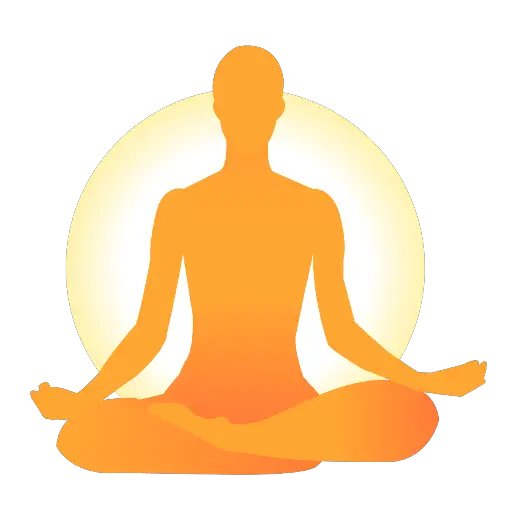
Below we are showing how to perform Kapalbhati Pranayam, one of the many types of Pranayama.
How to do Kapalbhati:
- To do Kapalbhati Pranayama, sit on the padmasana posture by laying a yoga mat or mat.
- Now put both your hands on your knees and place the palms in the knowledge posture.
- At this time the spine and head should be straight.
- Also keep your mind calm.
- Now close both eyes and take a deep breath two to three times and release slowly. Keep in mind that at this time you have to keep your mouth shut and neither breathe nor release from the mouth.
- Now exhale breath through the nose. Also, while exhaling, pull the stomach inward.
- After this, you have to exhale continuously and take lightly from your nose.
- You can do this for one to two minutes.
- Then you can start doing it again by taking a break of few seconds.
- You can do this yoga for 10 minutes.
Precautions:
- If someone has lung problems, they should avoid doing this yoga.
- Patients suffering from severe heart disease and high blood pressure should not do this yoga.
- Those with problems related to the respiratory system, do it only on medical advice.
2. Tadasana
Tadasana is made by combining two words of Sanskrit language, in which Tad means mountain and posture. In this yoga posture, the body appears upright and stable like a mountain. For this reason, it was called Tadasana. At the same time, according to a scientific research, doing yoga can boost the working capacity of the lungs. This can provide sufficient amount of oxygen to the cells of the body. At the same time, the name of Tadasana is also included in the list of Yogasan given in the article (12). As such, tadasana can be practiced daily to boost oxygen levels in the body.

How to do the Yoga:
- To do Tadasana, stand upright by laying yoga mats in a clean and open space.
- At this time, keep the ankles of both the legs close to each other. At the same time, keep both hands straight down and adjacent to the armpit.
- After this, bring both the palms forward and trap them together and take them slowly above the head.
- Then breathe in slowly and stand on your toes and pull the body upwards.
- Stay in this position for some time and maintain the balance of the body. Also, keep breathing and exhaling in a normal way.
- At this time, the entire weight of the body will be uniform on the toes of both feet.
- After this, slowly release the breath and come to the starting posture.
- Initially, this yoga process can be done four to five times. After this you can increase the order according to your ability.
Precautions:
Some precautions related to Tadasana need to be kept in mind, including: (13):
- Those who have headache, avoid doing this yoga.
- Do not do this asana if you have problems sleeping.
- People struggling with low blood pressure or low blood pressure should avoid doing this yoga.
3. Surya Namaskar
Surya Namaskar Yoga is created by combining two words. The first word in it is Surya i.e. sun and second salutations. This yoga is completed in 12 steps. At the same time, doing this yoga can promote blood circulation of the whole body. Also, regular practice of this yoga can work to increase oxygen in the body. In this case, we can say that oxygen in the body can be maintained by doing Surya Namaskar ..

How to do the Yoga:
- Surya Namaskar is a gradual way of doing yoga. Only by doing this in a sequential manner can it have its benefits. Know below the sequential way to perform Surya Namaskar:
- Pramanasana: First of all, stand upright by laying yoga mats. Then bring both your hands in front of the chest and join. At this time the person appears in the posture of salutations.
- Hastautanasana: In this phase, while taking long breath, raise both hands above the head in the salutation posture. At this time, keep in mind that both arms should be touching the ears. Also, try to move the upper part of the body as much as possible backwards.
- Padahastasana: Now while exhaling slowly bring both hands to the front and bow down on the stomach and try to touch the ground with both hands. At this time, the forehead must have been touching the knees.
- Ashva Sankalanasana: Then take a deep breath and sit on the right foot and move the left foot back as much as you can. Also, keep in mind that the knee of the left leg will be touching the ground in this posture. Staying in this position, lift the neck up and look at the sky.
- Parvatasana: In this phase, while exhaling, move the right leg backwards as well. Now try to raise the body from the middle by keeping the left and right toes in a straight line. At this time, both the palms and the paws will be on the ground. Also, keep in mind that the hands and feet should be straight at this time.
- Ashtangasan: To get into Ashtangasan, take a deep breath and put both knees on the ground. Then, without releasing the breath, touch the ground with the chest and chin. In this position, the waist and hips will be raised upwards.
- Bhujangasana: In this stage, give the vaccine on the floor to the waist without exhaling. Now try to lift the upper part of the waist slowly. At this time, both the palms should be on the ground and lift the neck up and look at the sky.
- Parvatasana: After this, you will have to come to the mountain again. For this, while exhaling slowly, try to lift the middle part of the body upwards. At this time, both hands should be straight and make the ankles touch the ground. Also, try to maintain eyesight at the navel.
- Ashwala Sankalanasana: Now take a long breath and bring the left leg towards the front and sit on it. At the same time, keep the right leg straight and keep the knee on the ground.
- Padahastasana: Then, while exhaling slowly, bring the right leg in front and straighten both the legs with the hands resting on the ground. Also try to touch the knees with the forehead.
- Hastautanasana: After this, take deep and long breath, raise both hands upwards and try to bend backwards according to your ability by joining the palms together.
- Pranamasana: In the last phase, the pranama is to come again in the posture. For this, stand upright and join hands by bringing them in front of the chest and come in a state of salutations.
Precautions:
- Do not do this asana during pregnancy and menstrual cycle.
- The person affected by hernia should not do this asana.
- High blood pressure patients should avoid doing this Yogasana.
- If someone has a backache, they should not do this asana.
4. Trikonasana
The trigonasana is counted in an asana of hatha yoga. It is made up of a combination of two words, in which the first triangle means three-angled and the posture. During this yoga, a triangle is formed from the body. At the same time, trigonasana can prove to be beneficial in improving oxygen levels in the body. In fact, in a research, some people were given some selective yogasanas, which also saw an improvement in oxygen levels, among other benefits. The name of Trigonasana was also included in these asanas. As such, regular practice of trigonasana may prove helpful in increasing oxygen levels.
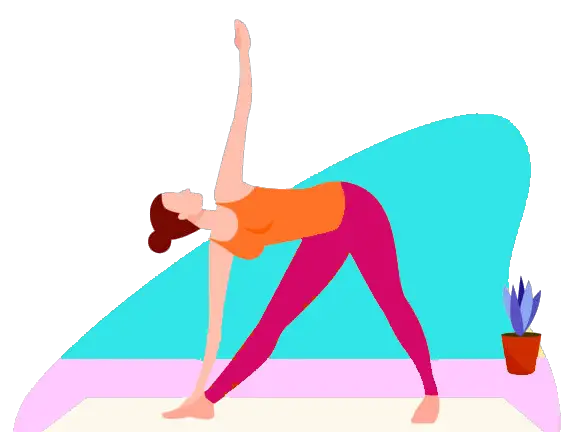
How to do the Yoga:
- To do Trigonasana, stand upright by laying yoga mats or mats in a clean and open space.
- At this time, keep a distance of one to two feet between the two legs and keep the hands affixed to the body.
- Now spread both your arms away from the body to the shoulders simultaneously.
- Then, while breathing, raise your left hand and close it with the ear and take out the right leg and bend it.
- After this, while exhaling, lean towards the right side from the waist.
- Knees should not be bent at this time and keep the left hand close to the ear.
- After this, try to bring the left hand parallel to the ground and also try to touch the left ankle with the right hand.
- Remain in this posture for a few seconds and keep the breathing and breathing process normal.
- Now reverse the action of this yoga and come to the previous posture.
- Now this cycle is half done, after a few seconds pause also do it from the other side.
- Three to four cycles of this yoga can be done.
Precautions:
- Do not perform this Yogasana in the event of high blood pressure (16).
- If someone has back pain, then avoid this yoga.
- This posture should not be done if there is severe pain in the back and neck.
- Those who are more dizzy should stay away from this yoga.
5. Matsyasana
Matsyasana is also known as fish pose in English. Matsya here means fish and asana means posture. During this yoga, the shape of the body appears like a fish. According to a scientific research, blood circulation can be improved by doing yoga. Matsyasana is also included in the yoga to be studied. At the same time, we have also mentioned earlier in the article that oxygen can improve in the body when blood circulation improves. On this basis, it can be said that Matsyasana can work to increase oxygen.

How to do yoga:
- For this yoga, spread yoga mat or mat and get into the position of Padmasana.
- Then slowly lie down, leaning back on the back.
- Now, while trying to hold the elbows on the ground, hold the left foot with the right hand and the right foot with the left hand.
- After this, while taking a long breath, lift the chest upwards and move the head backwards according to your ability.
- Remain in this posture for a while and breathe in and out regularly.
- After this, while doing yoga in the opposite direction, come to the previous posture.
- 5-6 circles of this yoga can be done.
Precautions:
- Persons with high BP or low BP should not do this.
- If you have insomnia or migraine problems, avoid doing it.
- If there is a problem with the lower back or neck, stay away from matsya.
6. Ardha Matsyendrasana
Ardh Matsyendrasana is made up of four Sanskrit words Ardh, Matsya, Indra and Asan. This asana is not easy to do, but it can be done easily in a few days due to its regular practice. At the same time, with the help of this yoga, it can also help to maintain the right level of oxygen in the body. Indeed, a research related to the subject suggests that the practice of Ardh Matsyendrasana can help supply oxygen to the lungs. This can help maintain the correct oxygen level in the body.
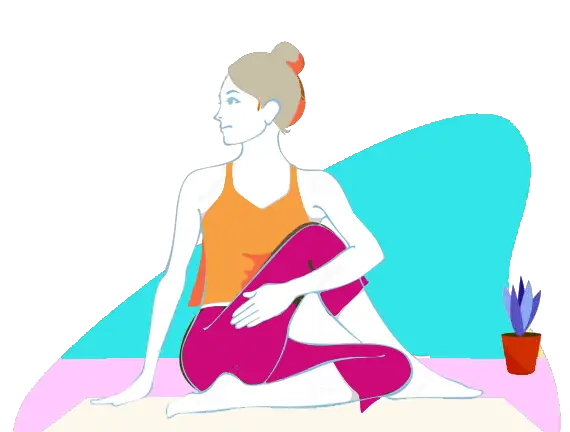
How to do yoga:
- First of all sit on the posture of Dandasana by laying yoga mats. At this time keep the arms, legs and spine straight.
- Then bend your right leg from the knee and bring it above the left foot and place it next to the knee of the left leg.
- Now bend the left leg and place the heel of the left foot under the right hip.
- Then take the right hand above the left knee and keep it close to the thigh and try to hold the ankle of the left foot with the right hand.
- After this, bend the neck to the left to the best of your ability and look back. Also, keep the reed bone upright during this time.
- Remain in this posture for a few seconds and breathe in and out normally.
- After this, reverse the action of yoga and come back to the previous posture.
- This half cycle has happened, now repeat this action from the other side as well.
- Three to four cycles of this yoga can be done daily.
Precautions:
- If you have recently had heart or stomach surgery, then avoid doing this yoga.
- Patients struggling with hernia and ulcer problems should stay away from this yoga.
- Pregnant should not do this yoga.
7. Bhujangasana
Bhujangasana can also be included in yoga to increase oxygen levels. Bhujangasana is known as ‘Cobra pose’ in English. This is said to be because during this asana the shape of the body appears like a snake. Performing Bhujangasana yoga can improve blood circulation and oxygen content. This is confirmed in a research related to this.
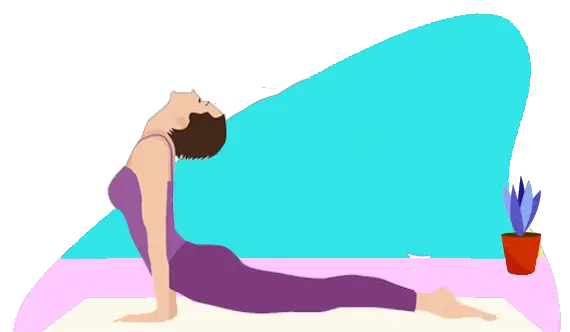
How to do yoga:
- For this yoga, by laying a yoga mat or mat, lie down on the stomach and at the same time keep both hands near the head and rest the forehead on the ground.
- At this time, there will be a fit distance between both the legs and the trunk.
- After this, bring both the palms equal to the shoulders and then take long breath, apply pressure on the ground with hands and raise the body up to the navel.
- In order to lift it, first the head, then the chest and finally the navel section will rise up.
- After coming in this posture, take the view towards the sky and stay like this for a while.
- At this time, the weight of the body should be the same on both hands. Also keep breathing regularly and exhale.
- After staying in this posture for a while, slowly exhale and return to the initial posture.
- Three to five cycles of this yoga can be done.
Precautions:
In some cases this yoga should not be done, these include :
- At the time of menstruation
- during pregnancy
- Asthma problem
- Carpal tunnel syndrome (tingling and numbness in the arm and arm)
- Joint pain
- Fracture in the ribs or wrists
8. Makarasana
If you want to know how to increase oxygen level with yoga, then it can be done. A medical research published on the website of NCBI (National Center for Biotechnology Information) has given that the respiratory system can be kept healthy by doing yoga. This can help maintain oxygen levels. The name of Makarasan is also included in the yoga to be done in this research. Also, this yoga can also boost lung capacity.
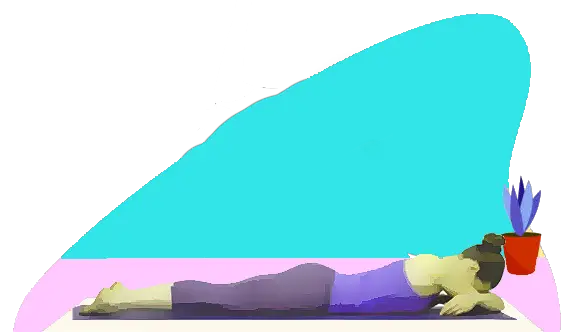
How to do yoga:
- To do this yoga, lie on your stomach by laying yoga mats in a clean and clean place.
- At this time keep both arms and legs straight. Also, keep a distance of one to two feet between the two legs.
- Now leave the body completely loose.
- Then raise the head, shoulders and chest lightly.
- After this, raise both hands slightly above the shoulders and bend with the elbow and place one wrist on top of the other wrist.
- Now put the head on the palms and close the eyes with a long breath.
- Then calm the mind, remove the bad thoughts from the mind and keep breathing and exhaling normally.
- After a few minutes, open your eyes and come to the starting posture.
- You can do this yoga daily for 10 to 15 minutes.
Precautions:
- Pregnant women should not do this yoga.
- Do not do this yoga in the event of a fracture in the elbows or arm.
- Stay away from this asana with high obesity and high blood pressure.
9. Balasana
Balasana is also known as ‘Child Pose’. This yoga is named after combining the two Sanskrit words Baal and Asana. In this, Baal means child and posture means posture. During this yoga, the shape of the body looks like a small child. At the same time, doing this yoga can improve blood circulation, which can help in keeping the amount of oxygen in the body balanced.

How to do yoga:
- To do Balasan, spread yoga mats in clean place and come to Vajrasana.
- Now, while taking long and deep breaths, raise both hands towards the sky. During this, maintain a small distance between the two hands and the palms should be open.
- Then, while exhaling slowly, tilt the upper part of the body forward and let the forehead rest on the ground. During this time, both hands will be on the ground.
- In this state, both the hands will be in front and the head will be on the ground and the chest will rest on the thighs. Also keep breathing and exhaling normally.
- Now, according to your ability, try to remain in this posture for some time.
- After this, after taking long breath, come to Vajrasana and while exhaling, lower your hands.
- Three to four cycles of this yoga can be done daily.
Precautions:
- Avoid this yoga in the event of a knee fracture or injury.
- Garbhavati should not do this yoga.
- If there is a problem with the front bending, do not do it.
10. Vrikshasana
Vriksasana i.e. tree pose is also considered a type of hatha yoga. During this yoga, the body looks like a tree. This asana can also be done in the form of yoga to increase the oxygen level. Actually, it is believed that by doing this yoga, the respiratory system and blood circulation can be improved. This can also have a positive effect on the oxygen level of the body. At present, there is a lack of scientific study in this regard.
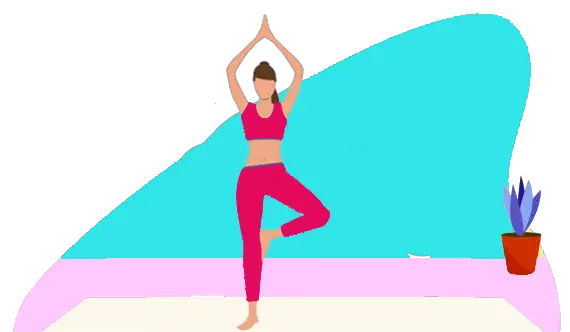
How to do the Yoga:
- For this yoga, stand up straight by laying yoga mats.
- Now bend the left leg from the knee and try to keep the sole of the left foot on the thigh of the right foot. At this time, keep in mind that the right leg should be straight and the leg should be properly balanced.
- When the balance of the body is properly formed, then take a deep breath and take both hands together above the head and make a posture of salutations.
- At this time, the waist, spine and head should be in a straight line. Also, the balance of the body should be maintained.
- Now try to remain in this posture for a few minutes and keep the process of breathing and exhalation normal.
- After this, do the opposite of yoga while exhaling and come to the starting posture.
- It has been half cycle, now repeat it from the other side as well.
- Three to four cycles of this yoga can be done.
Precautions:
- People who are suffering from obesity should not do this yoga.
- If someone has arthritis problem, then they should stay away from this asana.
- Stay away from this asana even if you have low or high blood pressure and migraine problems.
- Garbhavati should not do this yoga.
- If someone’s head bounces, they should avoid doing this yoga.
FAQ’s
What are the symptoms of not having enough oxygen in the blood?
Difficulty in breathing and blue color of face and lips can be symptoms of lack of oxygen in the blood. We have explained in detail in the article above the information related to its symptoms.
Which foods help increase oxygen in the blood?
To increase the amount of oxygen in the blood, you can eat foods rich in iron. Also, a low carbohydrate-rich diet can help (26). Dried plums, raisins, apricots, soybeans, rajma, broccoli and spinach can be consumed in iron-rich foods. Apart from this, medical advice can also be taken in this subject.
How can I increase my oxygen levels naturally?
Naukasana, Dhanurasana, Uttrasana, Bhujangasana, Balasana, Vriksasana and Surya Namaskar as well as some other yoga can be done to increase the oxygen levels in the blood naturally. The way to do these yoga is explained in detail in the above article.
Does pranayama increase oxygen levels?
Yes, pranayama can increase oxygen levels. Actually, breathing exercises done during Pranayama can work to increase the amount of oxygen. For this, pranayama like Kapalabhati and Anulom-Antonyms can be done.
How can one increase oxygen levels in a room?
To increase oxygen levels in a room, keep the window open. Also, small plants can be placed in pots in the room or near the window. These plants can help clean the air. At the same time, opening the windows and doors of the room can be taken for a while. If someone has a habit of smoking, he should quit this habit immediately. In addition, breathing exercises and yoga should be done regularly.
Which exercise is best for oxygen?
Breathing exercises can be considered best for increasing the amount of oxygen. Prone breathing, buteco nose breathing, alternative nostril breathing and lion breathing exercise can be done for this.
(Disclaimer: This should not be considered medical advice. Please check with your doctor on medical procedures.)

